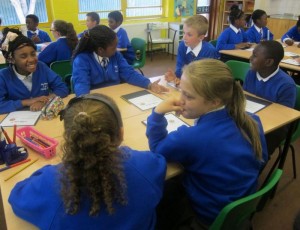 Our world is changing and if we as adults do not pay attention to how we are preparing our young people for the world they are emerging into and will be co-creating we are doing them and ourselves a deserves. Our schools need to be shifting to meet this new challenge and be both responding to and supporting the creation of the next generation of leaders. I look around our world today, and it is a very different world to when I grew up and went to school. Young people are being educated for jobs that are yet to be invented, using knowledge we don’t yet know, to do things we can’t yet imagine. I notice youth unemployment is raising and those that are getting work are being asked by CEOs and HR consultants to possess a very different set of skills – they need to be resilient, aware of their interconnectedness and have an ability to co-create alongside others in a creative and innovative way – rather than regurgitate facts, they need to know how to find the facts as they change, rather than follow the rules set by others, they need to be able to access in a given moment what are the rules and are they the right rules that connect to values and if not how can I be impacting on the rules. They need to be able to think independently yet at the same time need to be able to work as a collective interconnected group acknowledging that the greatest innovation does not stand in the singular star but in the collective wisdom. Claus Otto Scharmer in his book Presencing: Illuminating the Blind Spot of Leadership speaks of the need to stop looking to the past for solutions to today’s and future challenges, but the need to look to the future that is yet unknown to find the solutions for today’s challenges – to sense what is emerging and then actualize it. When speaking of social fielding he shared the analogy of an agricultural field where there are two fields, one visible on the surface, and one living, pulsing organism that lies below the surface. The quality of the crop is dependent on both the visual and hidden fields. If we are to create healthy, strong, blossoming crops in the way of the next generation, it is not enough to pay attention to that which is on the surface, the taught curriculum, the maths, science, biology, history and so on, we need to be paying attention to that which is hidden and yet is vital to the growth and development of children. We need to be paying attention to the messages we give them about what is valued and needed in our world. We need to be supporting young people to think about what kind of person they will be alongside what they will do. That is the true test of our education system. Elana Friedman 26 November 2012
Our world is changing and if we as adults do not pay attention to how we are preparing our young people for the world they are emerging into and will be co-creating we are doing them and ourselves a deserves. Our schools need to be shifting to meet this new challenge and be both responding to and supporting the creation of the next generation of leaders. I look around our world today, and it is a very different world to when I grew up and went to school. Young people are being educated for jobs that are yet to be invented, using knowledge we don’t yet know, to do things we can’t yet imagine. I notice youth unemployment is raising and those that are getting work are being asked by CEOs and HR consultants to possess a very different set of skills – they need to be resilient, aware of their interconnectedness and have an ability to co-create alongside others in a creative and innovative way – rather than regurgitate facts, they need to know how to find the facts as they change, rather than follow the rules set by others, they need to be able to access in a given moment what are the rules and are they the right rules that connect to values and if not how can I be impacting on the rules. They need to be able to think independently yet at the same time need to be able to work as a collective interconnected group acknowledging that the greatest innovation does not stand in the singular star but in the collective wisdom. Claus Otto Scharmer in his book Presencing: Illuminating the Blind Spot of Leadership speaks of the need to stop looking to the past for solutions to today’s and future challenges, but the need to look to the future that is yet unknown to find the solutions for today’s challenges – to sense what is emerging and then actualize it. When speaking of social fielding he shared the analogy of an agricultural field where there are two fields, one visible on the surface, and one living, pulsing organism that lies below the surface. The quality of the crop is dependent on both the visual and hidden fields. If we are to create healthy, strong, blossoming crops in the way of the next generation, it is not enough to pay attention to that which is on the surface, the taught curriculum, the maths, science, biology, history and so on, we need to be paying attention to that which is hidden and yet is vital to the growth and development of children. We need to be paying attention to the messages we give them about what is valued and needed in our world. We need to be supporting young people to think about what kind of person they will be alongside what they will do. That is the true test of our education system. Elana Friedman 26 November 2012